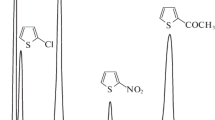Summary
-
1.
With the aid of an automatic calorimeter having constant heat exchange and an adsorption apparatus with a capillary microburet, determinations were made of differential heats of adsorption and the adsorption isotherms for benzene vapor on carbon black, both graphitized and in its original oxidized state. Much of the surface of graphitized carbon is homogeneous and is filled at a constant heat of adsorption. The adsorption isotherm is satisfactorily described by the Langmuir and BET equations.
-
2.
The relation of the free energy, total energy, and entropy of adsorption to the surface coverage was investigated. The respective standard values for adsorption of vapor and for wetting were determined.
-
3.
A theoretical calculation of the adsorption energy of benzene was carried out by means of a summation of the dispersional interactions with the 100 nearest atoms of the graphite lattice, account being taken of interactions with the remaining atoms with the aid of an integral formula. The calculated value of the adsorption energy is very close to the measured heat of adsorption.
-
4.
Comparison are made between the isotherms and heats of adsorption of benzene and hexane vapors. As requried by theoretical calculation, in the unimolecular region the heat of adsorption of benzene is considerably less than that of hexane.
Similar content being viewed by others
Literature cited
N. N. Avgul, G. I. Berezin, A. V. Kiselev and I. A. Lygina, J. Phys. Chem. 30 2106 (1956).
A. V. Kiselev, V. F. Kiselev, N. N. Mikos, G. G. Muttik, A. D. Runov and K. D. Shcherbakova, J. Phys. Chem. 23 577 (1949).
V. P. Dreving, A. V. Kiselev and Yu. A. Eltekov Proc. Acad. Sci. USSR 86, 349 (1952).
R. N. Smith, C. Pierce and H. Cordes, J. Am. Chem. Soc. 72 5595 (1950).
A. P. Karnaukhov, A. V. Kiselev and E. V. Khrapova, Proc. Acad. Sci. USSR 92 361 (1953).
P. A. Tesner and M. M. Polyakov, Prov. Acad. Sci. USSR 93 1061 (1953).
A. V. Kiselev Yu. A. Eltekov, J. Phys. Chem. 29 904 (1955).
F. E. Bartell and R. M. Suggitt, J. Phys. Chem. 58, 36 (1954).
V. F. Kiselev, Proc. Acad. Sci. USSR 89 113 (1953).
L. Pauling, Nature of the Chemical Bond Moscow and Leningrad, State Chem. Press, 1947
F. London, Problems of Kinetics and Catalysis, United Sci. Tech. Press, Leningrad, 1937, 3, p. 329.
J. G. Kirkwood, J. Phys. Z. 33 57 (1932).
R. Barrer, Proc. Roy. Soc. A161, 476 (1937).
A. V. Kiselev, Proc. Acad. Sci. USSR 106 1046 (1956).
Author information
Authors and Affiliations
Rights and permissions
About this article
Cite this article
Avgul, N.N., Berezin, G.I., Kiselev, A.V. et al. Heat of adsorption of benzene vapor on carbon blacks thermodynamics of the process and the adsorption forces. Russ Chem Bull 5, 1339–1345 (1956). https://doi.org/10.1007/BF01177699
Received:
Issue Date:
DOI: https://doi.org/10.1007/BF01177699



